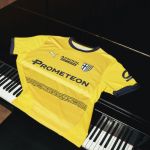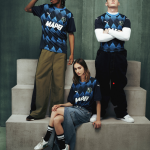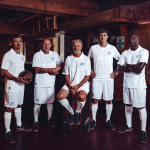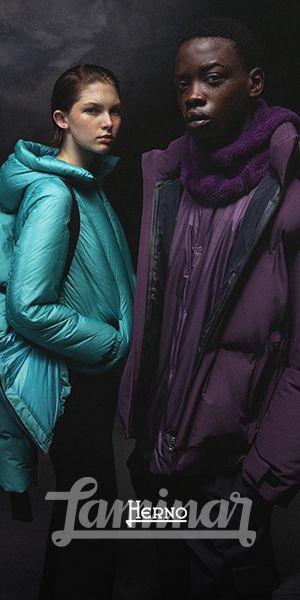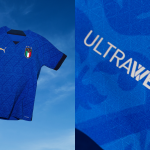
Behind the scene of the ultimate PUMA's ultralight jersey
Interview with Stefano Favaro, the creative director behind the new Italy jersey
October 15th, 2021
The feeling was one of being on a date with history, one that you only realise afterwards, once it's all over. That's exactly how the launch of the Azzurri's new jersey went, with PUMA creating the lightest jersey ever and breaking all barriers with its new ULTRAWEAVE technology. Created following years of testing and trials with PUMA athletes, it is an extremely lightweight fabric engineered to optimize performance. The jersey has a base frame of only 72 grams, with an extreme weight reduction achieved thanks to the woven fabric characterized by a 4-way mechanical stretch that will make players faster and more dynamic.
During the event we had the opportunity to have a chat with Stefano Favaro, Creative Director Teamsport at PUMA, one of the many minds behind this super fabric that has completely revolutionised both the game jersey and the trousers. Who knows if the fabric might soon be adapted for other sports, such as athletics, where something like this would be fundamental as every thousandth of a second can make a difference, or for other items belonging to the football sphere, such as shoes. But for the moment the revolution belongs to the shirt of the European champions and in all likelihood from next season it will be extended to all clubs of the German brand.
First of all, what we wanted to know was what it feels like to achieve a historic result like this, which in itself is reductive to define unique or revolutionary, since no one before has achieved something like this.
You feel a mixed feeling divided between satisfaction and nervousness, because it was a long project to develop, the clothing is undoubtedly difficult to innovate, Italy since the early days (after the wool jerseys) has played with polyester and still uses it for the national teams but not only. Among other things, there are often many internal and external contrasts in this type of thing. Internal, in the sense of the visualisation of the product or how the product presents itself in terms of design and material, how much it costs. Then there are the external obstacles of testing with players of all levels, plus a whole host of feedback coming in from social media, which is what gives you the feeling of nervousness, even though we've only received good feedback. But in general there is a lot of satisfaction, not only mine clearly but also those who worked on this project, for those who designed the assembly, because in the end this jersey only has two pieces, it has been simplified substantially. In addition, there is an important part of sustainability because the jersey is totally recycled.
What gave you the idea of creating something so light and then adapting it to the world of football?
The inspiration has always been to create something fast, we are always faithful to our mantra "Forever Faster". We want to be the first, and we were the first in shoes with the V106, which was launched in 2006 with a similar material, and also in clothing, creating a full kit for Cameroon. We've never stopped there, and in this case there are fewer restrictions in the clothing because maybe having a super light shoe isn't always good, you always have to feel a bit of weight, but in the clothing this restriction is undoubtedly lessened, the important thing is that it doesn't bother you. For this shirt, the main inspiration was to give the impression of putting a flag over your body, like having a sort of veil. This jersey allowed us to be both light and strong, which are two very, very important things.
You anticipated us, PUMA's ambition as seen in these years is always to have been the fastest, looking at the future what can be the next steps? But above all, after having achieved something like this, what is the stimulus that keeps you going?
Difficult question, I repeat the evolution of clothing is much more difficult than footwear, getting to this point has already been very difficult, a fantastic achievement, I must say. Working on lightness once we've reached this point is perhaps no longer the way forward, we've reached a higher level. The next step can be to work on the next silhouettes, so how this lightness here helps to work on different compositions, to work on the fit as well. In the future, it could be that the research will be more on the fitting and work more on the "style", let's say, pass me the term. The important thing was to get here and that's it, honestly.
The shirt of Italy was undoubtedly one of the most beautiful of the edition of EURO2020, we know what are the references, the idea of the renaissance, intense also as a real rebirth of the team after the debacle, but the basic idea from where it was born?
When we started thinking about it, we wanted to represent the rebirth we talked about. Basically, we took inspiration from various monuments all over Italy, from Siena to Naples to Lecce, practically everywhere. We identified some symbols of these monuments in common, obviously they are city and religious symbols. In the end we turned to a symbol somewhere between a halberd and a flower to give the idea of this flower being reborn. We didn't choose a specific coat of arms of a city, but just something that represented the floral rebirth of the whole country.
We end our interview with a little curiosity: compared to the jersey with which we won the European championship, the collar has disappeared. Was this a choice due to weight reduction or just aesthetic?
It would have been too banal for the technology to keep the same design, and a collar with a double turn would have increased the weight. We had decided to clean up the jersey by eliminating everything and have the maximum technicality and maximum lightness while maintaining, or almost maintaining, the same style of that jersey.












